| | Description | Life history | Hosts and damage | Control | Questions | Observations in 2000 | Comments | Industry sponsors
Apamea devastator (Brace)
Description
The glassy cutworm is a sporadic pest of grass crops and turf throughout much of North America. It has occasionally caused serious damage to grass seed fields in the U.S. Pacific Northwest and the Canadian Prairie Provinces. The glossy, semi-translucent greenish-white or grey larva lacks body markings, but has a prominent reddish brown head and neck shield (Figure 1). Mature larvae are 35-40 mm (about 1.5 inches) in length and pupate in the soil near the host plant. The spindle-shaped pupae, within which the transformation to the adult moth occurs, is reddish-brown in colour and about 20 mm in length. The adult is a nondescript, medium sized (35-40 mm wing span) greyish miller moth with a scattering of dark markings on the forewings (Figure 2). The eggs, which are 0.55 mm in diameter, are usually laid on the upper surface of a grass leaf, near the base (Figure 3). Newly laid eggs are glistening white, but progressively darken until they hatch after about one week.
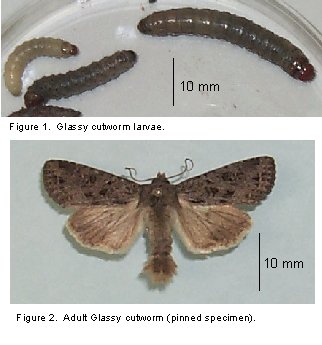
Life History
Glassy cutworm moths are in flight from July to early September, although most eggs are laid during August (Figure 5). After hatching, the larvae immediately begin to feed on the host plant and will usually be about half grown by freeze-up. The cutworm overwinters as a partly grown larva and resumes feeding again early the next spring as soon as new green growth appears. The larvae feed underground, or in the case of bunch grasses, within the crown and rarely come to the surface. They pupate in the soil by the end of June. There is one generation per year.
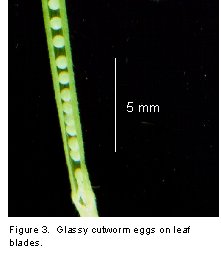
Hosts and Damage
The glassy cutworm is most commonly associated with grasses and turf but may attack cereals, corn and vegetables, particularly if these crops are planted on newly broken sod or in crops infested with grassy weeds the previous fall. Larvae damage grass stands in the fall and following spring by feeding on stems and crown at or below the soil surface. Apparently, larvae sometimes pull severed leaf below the soil surface until it is entirely consumed. Commonly infested grasses are tall and creeping red fescues, timothy, bluegrass, and brome. Low, and even moderate, infestations may not cause noticeable damage if growing conditions are favourable. Drought appears to be an important factor favouring population increases of glassy cutworm. The severe outbreak in the Peace River Region in 2000 followed two years of drought.
Control
There is no established economic threshold for glassy cutworms in crops or pastures. Newly broken land and summer fallow with grassy weeds should be well cultivated during August to prevent new growth suitable for egg laying. Fields at risk should be monitored for evidence of browning-off or unusually poor growth during both the fall and early the next spring. Damaged or sickly plants should be dug up and the roots and surrounding soil searched for the presence of cutworms. Insecticides, if required, should be applied with as high a water volume as is feasible (³ 200 L/ha). Light to moderate rain within a week after application will enhance efficacy. Numerous beneficial insects, including both predatory ground beetles and parasitic wasps and flies, were observed in the outbreak populations of glassy cutworm in the Peace River Region in 2000. In some fields, 50% of cutworms were parasitized. These natural enemies are often effective in suppressing cutworm populations below damaging levels. Therefore, unnecessary use of insecticides should be avoided.
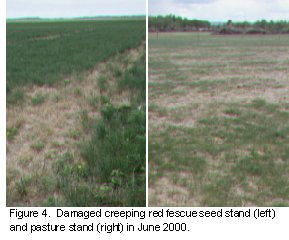
For the most up-to-date chemical recommendations visit the Insecticide Selector.
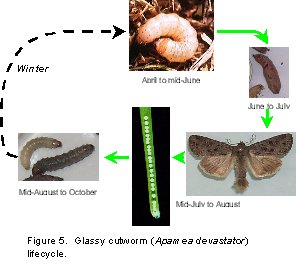
Questions
What host crops are affected?
Any fresh grass or cereal growth present between July until early September may be attractive to the female moths for egg laying. Newly hatched larvae will feed on whatever green plant material is present until freeze-up. They will then resume feeding the following spring. Crops affected in the Peace in 2000 were creeping red fescue, tall fescue, timothy, and meadow brome. In one case, seedling meadow brome was attractive for egg laying and the subsequent larval population destroyed a promising stand. Foxtail barley was frequently infested as was quackgrass in some pastures.
What determines plant damage?
Damage will vary according to plant vigour, moisture levels and larval abundance. Healthy, vigorous stands can tolerate more cutworms than stands that are under environmental stress.
How do glassy cutworms damage the plant?
The larval stage feeds on the plant. Although they are referred to as cutworms, the pest is not a worm but a juvenile moth also referred to as a larva or caterpillar.
When do glassy cutworms feed?
If the soil temperature is warm enough for grass to grow, the larvae will be active and feeding. Larvae start off very small and will not cause much damage until late in the fall. The extent of fall damage probably varies considerably between years, depending on the weather.
Observations in 2000
- Sod webworms and several other species of cutworms were observed in fescue fields in the Peace River Region in 2000. Sod webworms are a potential pest of grass seed crops should they become very numerous. However, they individually cause much less damage because they are smaller than glassy cutworms. Non of the other cutworms, including common crop pest species such as red-backed, and dark-sided cutworms, were numerous to be of concern.
- In some severely damaged fields in the spring, the above portion of grass tufts could be easily kicked free. This damage is now attributed to cutworm feeding the previous fall that removed most of the crown tissue.
- Cutworms were rarely observed to pull severed grass blades under the surface for complete consumption, contrary to published reports. Instead, the larvae were wasteful feeders and continued to clip off surrounding blades of grass rather than completely consuming the clipped ones.
- Glassy cutworm damage was observed spreading from beneath combined chaff strips, beneath residue, in high spots in fields, and resembling silvertop damage.
- Four species of cutworms in the "glassy cutworm group" were present in fescue fields in the Peace River Region in 2000:
1. Apamea devastator (glassy cutworm),
2. Apamea inficita,
3. Apamea amputatrix (yellow-headed cutworm),
4. Apamea cogitata.
The true glassy cutworm (Apamea devastator) was the predominant species. All four species are morphologically similar as larvae, have similar life histories, and cause similar damage.
- Foliar applications of Lorsban and Decis produced variable control with results ranging from claims of 30-100% control. Applications followed by rain were usually more successful.
- Fescue seed stands were surveyed in the Grande Prairie and Fairview areas October 3 - 4 2000. Glassy cutworm larvae were found in half of the ten fields surveyed.
Comments
Insect monitoring
- There is no established economic threshold for glassy cutworms in fescue seed crops.
- Previous outbreaks of this species in grass occurred in the mid-1960's and 1970's in the Peace River Region. It is also an occasional serious pest in fescue in the Pacific Northwest of the U.S.A.
- Pheromone trap monitoring is not possible at present because no glassy cutworm pheromone is commercially available. Furthermore, no baseline data is available that would enable interpretation of trap catches.
- Monitoring for larvae in the fall and early spring can provide information on the pest potential. However, larvae will be extremely small and difficult to detect in the fall. Fall monitoring should not be attempted until the larvae have reached at least 10 mm in length.
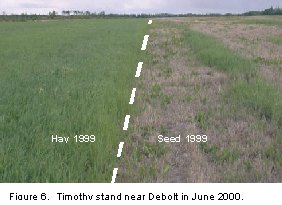
Glassy cutworm females lay eggs on green leaves of host plants. In 1999, one portion of a field (left) was cut for hay, but plant material in the remainder of the field (right) was left standing so plants could set seed. Glassy cutworm damage occurred only where plant material was left standing.
Control
- Glassy cutworm larvae rarely come above the soil surface. This makes them very difficult to control with contact insecticide applications.
- Late-instar stages exhibit a degree of resistance to insecticide applications whereas younger larvae are relatively more susceptible.
- High water volume (³ 200 L/ha) is recommended when applying an insecticide. This should provide better penetration of spray droplets into the grass crowns where the larvae are feeding.
- In Oregon, a fall application of Lorsban is made prior to rainfall or followed by irrigation. The moisture carries the insecticide into the crown and upper level of the soil where the glassy cutworms are located.
- Decis, Lorsban and likely Matador will remain active approximately 7 days following the application if there is precipitation.
Industry Sponsors
Peace River Region Forage Seed Association
Alberta Agriculture, Food and Rural Development
Westco
Cargill
Dow Agrosciences
UFA
United Grain Growers Limited (UGG)
Aventis
Beaverlodge Research Farm
Agriculture and Agri-Food Canada
Jennifer Otani1, Robert Byers2, Hugh Philip3, Lloyd Dosdall4, Calvin Yoder5
1 Agriculture and Agri-Food Canada - Beaverlodge Research Farm
2 Agriculture and Agri-Food Canada - Lethbridge Research Centre
3 B.C. Ministry of Agriculture, Food and Fisheries - Kelowna
4 Alberta Agriculture, Food and Rural Development - Edmonton
5 Alberta Agriculture, Food and Rural Development - Spirit River |
|